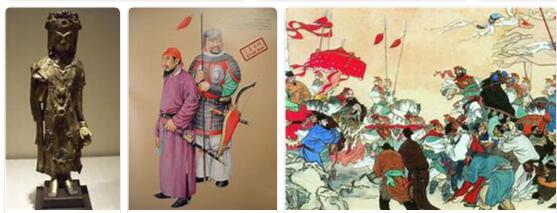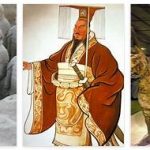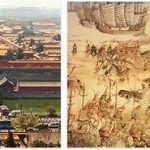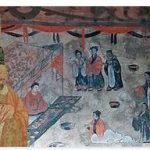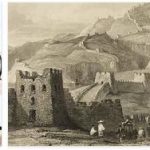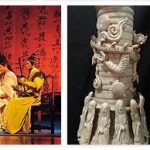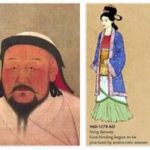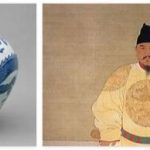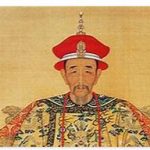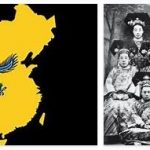During the period of the separation of the empires, the north and south of China also developed differently economically. In the north, v. a. self-sufficient agriculture; Trade and money economy were unimportant, taxes were levied in kind. In the much more productive South, agriculture generated surpluses, and trade (which was taxed) and monetary economy flourished.
Sui (581 / 589-618)
General Yang Jian (Yang Chien), who came from the northern Chinese military aristocracy, was given the imperial insignia in 581 by the last ruler of the Northern Zhou (Chou, 556-581), a successor state to the Toba-Wei, and founded Wendi (Wen-ti, 581–604) the short-lived but historically significant Suidynasty. It continued the aristocratic rule of a small group and maintained the institutions that had been tried and tested in the past centuries, so that one can speak of a continuity that stretched from the Northern Wei dynasty through the Sui to the beginning Tang dynasty. The Suidynasty, according to its self-image, claimed rulership over all of China, and this claim, i.e. the conquest of the south, could even be achieved relatively easily and without much bloodshed. With the incorporation of the elite of the south into the bureaucracy of its own dynasty, the conquest was assured of lasting success.
Under the second ruler Yangdi (Yang-ti, 604–617), the unification of the empire found visible expression in the expansion of the Imperial Canal, which connected the metropolitan areas of Chang’an and Luoyang with the Yangtze River Delta, the “rice bowl” of the empire. Another gigantic construction project in Yangdis was the repair of the Great Wall of China in the north. The Sui were successful in foreign policy by keeping the Turkic peoples of Inner Asia in check and their influence as far as Turkestan stretched; in the south they exercised a loose supremacy over Vietnam. Only the campaigns to Korea (612–614) failed – because of them and the mammoth projects that exhausted financial strength, the dynasty broke up. Her greatest legacy was the restoration of the state unity of China, which was not called into question even after the end of the Suidynasty. As an ideal, it left behind the idea that China itself should be surrounded by a politically and militarily dominated zone as well as independent states that are shaped by Chinese culture and Chinese political institutions.
Tang (T’ang, 618-907)
The northern Chinese military clan Li emerged victorious from the struggle to succeed the Sui and founded the Tang Dynasty. The first two rulers, Li Yuan (Li Yüan), as Emperor Gaozu (Kao-tsu, 618–627), and his son Li Shimin (Li Shih-min), as Emperor Taizong (T’ai-tsung, 627–649), created a central and local administration, the main features of which lasted until the end of the Empire. Its legal works, the first to be fully preserved, were also considered exemplary for centuries. Together with the other institutional innovations, they exerted a lasting influence on the neighboring peoples, v. a. to Japan, which imported and imitated the Tang civilization as a whole.
In terms of foreign policy, Taizong and his son Gaozong (Kao-tsung, 650–683) also followed up on the Sui’s successes. With war and diplomacy they tamed the Turkic empires of the steppe zone, conquered the oasis kingdoms of East Turkestan and pushed the borders of China far beyond the Pamirs to India and Persia. Foreigners, and with them exotic goods, now streamed across the Silk Road to China from the “Westlands”, which, in addition to its main export item, silk, now also exported protoporcelain. The great trade hubs of the empire, such as Yangzhou and Guangzhou (Canton), housed large colonies of foreigners within their walls; the Chang’an Imperial Residence (Xi’an) was the largest and most international city of its time. In addition to material culture, including fashion and pastimes, music and literature have also been shaped by foreign influences. Foreign religions such as Manichaeism, Zoroastrianism (Parsism), Islam and Nestorian Christianity (Nestorianism) first gained a foothold in China, a country located in Asia according to businesscarriers.com.
Military setbacks on the borders in the northeast by the Kitan and in the northwest by the Tibetans – more influenced by India than China – at the end of the 7th century were temporary. The situation at court was more serious, where after the death of the third emperor in 683 his widow Wu Zetian (Wu Tse-t’ien) - the only woman in the history of China – founded her own dynasty. In addition to the (allegedly) cruel style of rule of the empress and the expansion of a system of secret agents, the basis was a bureaucratic elite recruited through exams, which differed from the previous aristocratic elite. The next emperor, Xuanzong (Hsüan-tsung, 712–756), restored the rule of the Tang dynasty and led them into their most glamorous epoch, which is associated with poet princes such as Du Fu, Wang Wei and Li Taibo.
On the other hand, Xuanzong initiated far-reaching reforms: In the central administration, the previous balance of three central ministries was destroyed, and the Chancellor gained dictatorial power. Career officials were rolled back in favor of the emperor’s personal agents, including many eunuchs. The ideal of the unspecialized civil servant was undermined, the idea of uniform taxation suspended. Above all, however, the need for defense made it necessary to replace the old system of self-sufficient militias with a professional army under powerful military governors, mostly Turkish or Sogdian Origin, who increasingly claimed political rights. A military revolt (755–763) initially led by the An Lushan († 757) turned into a domestic and foreign policy disaster.
